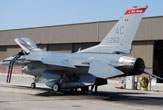
A squadron of aging U.S. Air Force fighter jets will be converted into drones that will be used for friendly fire target practice.
The Lockheed-Martin F-16 Fighting Falcon is the flagship jet of the Thunderbirds, the U.S. Air Force’s precision flying team, and is flown by the Air Force, Air Force Reserves and Air National Guard. But the fighter has been in service since 1979 and early models that are getting long in the tooth are now marching into retirement. They won’t go quietly, though. The Air Force has launched a program to convert many of these F-16s into QF-16 drones that will intentionally be shot down.
The Fighting Falcon is being turned into a clay pigeon that can streak through the sky at a speed in excess of Mach 2, or twice the speed of sound.
Boeing was awarded a $69.7 million contract from the Air Force to convert six F-16s as the first phase of the Q-16 program. Eventually as many as 126 of the sleek fighters will be converted into drones to be used as targets to test newly developed air-to-air weapons and tactics. [Read "7 Unmanned Airborne Warriors."]
The conversion is now underway at the company’s Cecil Field facility in Jacksonville, Fla. The first group of QF-16s will be turned over to the Air Force for testing in June 2012, said Bob Insinna, Boeing’s QF-16 program manager. The QF-16s will replace the current cro of QF-4 drones, which are converted versions of a Vietnam-era warhorse, the F-4 Phantom.
More agile targets
The number of usable F-4s is dwindling and the F-16s are higher performing aircraft that will provide a more realistic testing environment. The QF-16 drones will have the same performance capabilities as the F-16 fighter. The F-16, Insinna told TechNewsDaily, “is smaller, more maneuverable and more difficult to fight against.”
Get the world’s most fascinating discoveries delivered straight to your inbox.
When the F-16s arrive at Boeing’s facility, they are stripped down to remove unneeded parts, including the fighter’s Vulcan six-barrel 20mm cannon. Because the Air Force requires that the QF-16 be able to fly in both manned and unmanned modes, Boeing will modify the flight control system, working in a teaming arrangement with BAE, the original equipment manufacturer for the F-16 flight control system.
Other modifications to the F-16 include installation of a flight termination system that can destroy the drone if it goes out of control, command telemetry systems so the drone can be controlled from the ground and a scoring system to gauge the accuracy of air-to-air missiles fired at the drone.
Transformers
Boeing will convert the six F-16s in a parallel operation that uses a cellular approach much like an assembly line to advance the aircraft through each stage of the conversion process. It will take seven months for each F-16 to be converted into a QF-16.
The final stage in the conversion process is painting parts of the QF-16 a bright orange as a visual aid to signify it is a target drone. Typically, the tail and the tips of the horizontal stabilizers and wing are painted. The orange paint is the only readily apparent visual distinction between the F-16 and its doomed QF-16 derivative.
When the QF-16 is being flown by a pilot aboard it will be used to evaluate tactics and electronic warfare and electronic countermeasures such as radar jamming. Switching over to autonomous operation is “just a flip of a switch,” said Insinna.
The QF-16 may have an active retirement, but it won’t be a long one. A drone on average has an operational lifespan of 50 to 300 hours, he said.


